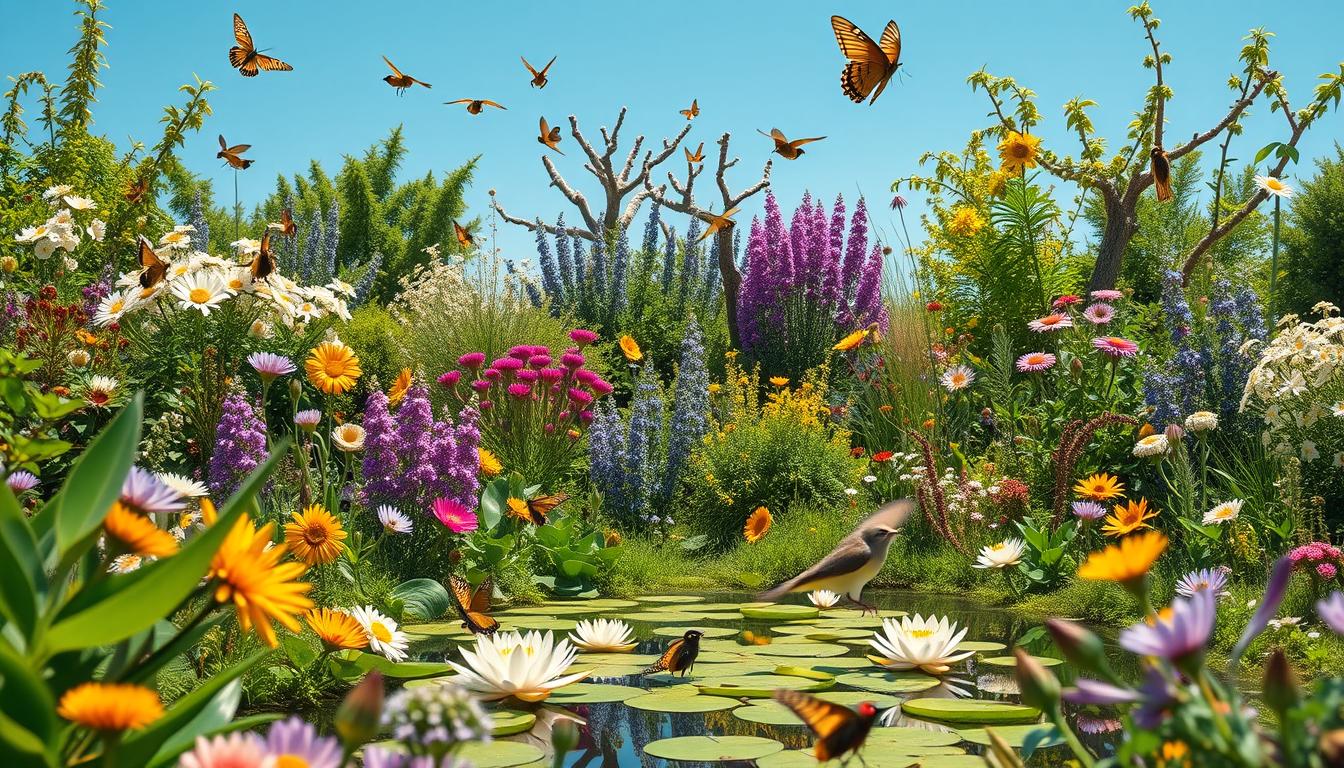I’ve always loved making my garden a haven for wildlife. I’m thrilled to share how I did it. By using green gardening methods, I drew animals to my yard. This not only helps the planet but also lets me enjoy nature right at home.
My garden’s success comes from being a home for local wildlife. This approach helps keep our environment healthy. By making your yard a wildlife haven, you support the local food chain and balance nature.
Creating a wildlife garden takes planning, patience, and hard work. By choosing plants that fit your area and using eco-friendly gardening, you can make a wildlife paradise. In this article, I’ll share my best tips for making your garden a wildlife-friendly space. We’ll cover everything from picking the right spot to adding water features and food sources, all while focusing on green landscaping and welcoming wildlife.
Why I Decided to Create a Wildlife-Friendly Garden
I’ve always been drawn to the natural world and its importance. Learning about human impact on the environment made me want to help. So, I started exploring ways to garden that support local wildlife.
My Love for Nature
As a kid, I spent hours outdoors, watching plants and animals. This taught me to love and protect nature. I wanted my garden to be a safe space for native plants and animals.
The Benefits of Biodiversity
Native plants are key for biodiversity, offering food and shelter to many species. My garden became a home for local wildlife. It also made my outdoor space more beautiful and interesting.
Some plants that attract pollinators include:
- Butterfly weed
- Bee balm
- Black-eyed Susan
By gardening in an eco-friendly way, I help preserve local wildlife. And I get to enjoy a beautiful, thriving garden.
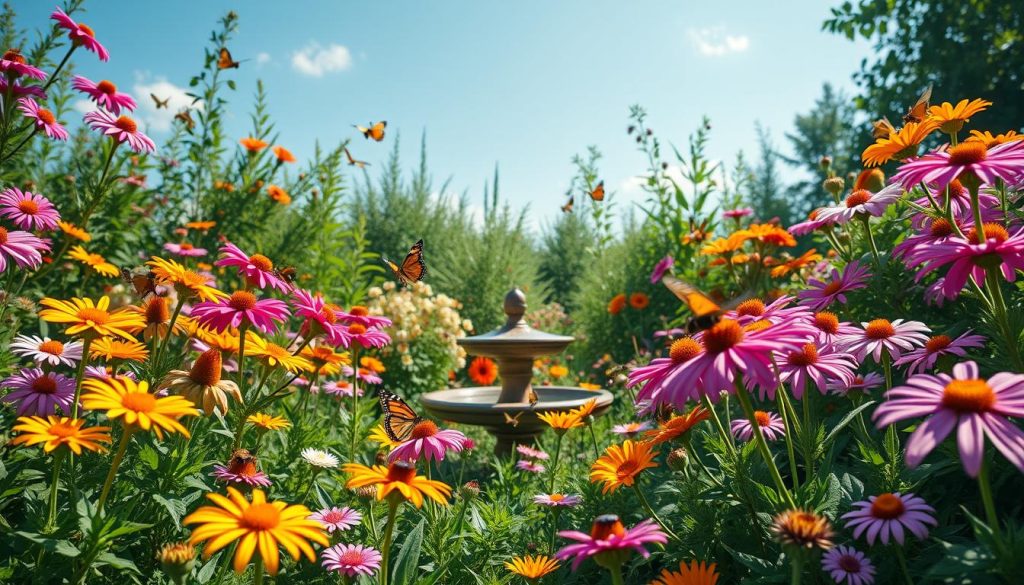
Choosing the Right Location for My Garden
Choosing the right spot for your wildlife garden is key. It affects what plants and animals can live there. A good spot attracts many species, making your garden a true sanctuary.
Factors to Consider
When picking a spot, think about a few things. These include:
- Soil type and quality
- Moisture levels
- Wind direction and speed
- Existing vegetation and wildlife
By considering these, you can make a garden that’s great for local wildlife.
Sunlight and Shade
Sunlight and shade are also important. Different plants and animals need different amounts of each. So, pick a spot that meets their needs. 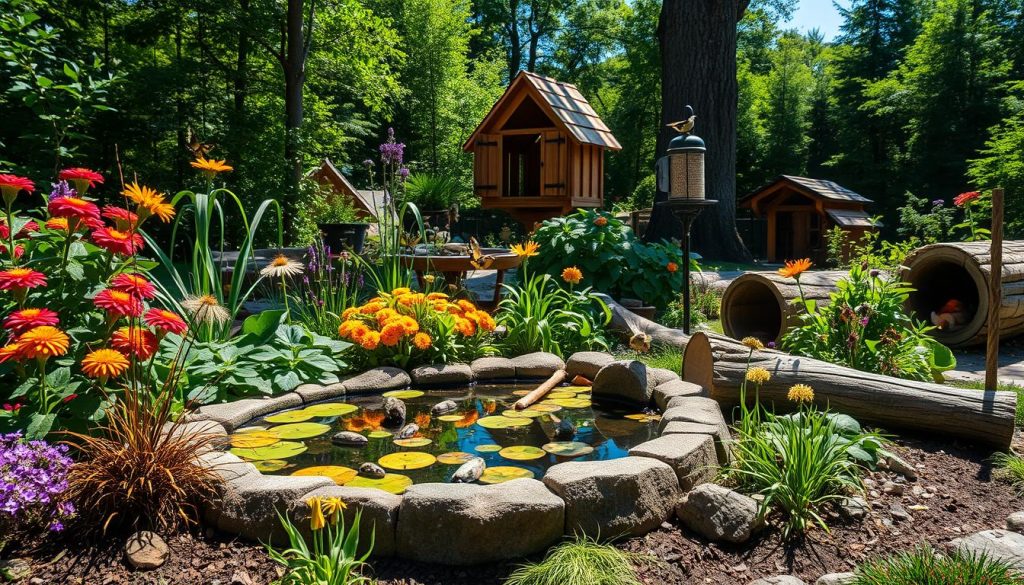
| Location | Sunlight Requirements | Shade Requirements |
|---|---|---|
| Full sun | 6+ hours of direct sunlight | Minimal shade |
| Partial shade | 4-6 hours of direct sunlight | Some shade |
| Full shade | Less than 4 hours of direct sunlight | Significant shade |
Planning My Wildlife Garden Layout
Creating a wildlife-friendly garden needs careful planning. You should design zones for birds, butterflies, and bees. This way, you attract wildlife to your yard. Eco-friendly gardening practices help create a thriving ecosystem for many species.
First, think about the wildlife you want to attract. Choose native plants for food and shelter. Add birdhouses, bat boxes, and insect hotels for more species.
Zones for Different Wildlife
- Bird zones with native plants and birdhouses
- Butterfly zones with nectar-rich flowers and host plants
- Bee zones with pollen-rich flowers and bee hotels
Paths and Accessibility
Don’t forget paths and accessibility in your garden design. They help you maintain and enjoy your garden. They also make it safe and welcoming for wildlife. Use eco-friendly materials like wood chips or gravel for paths.
Include benches or seating areas. They encourage relaxation and help you observe wildlife.
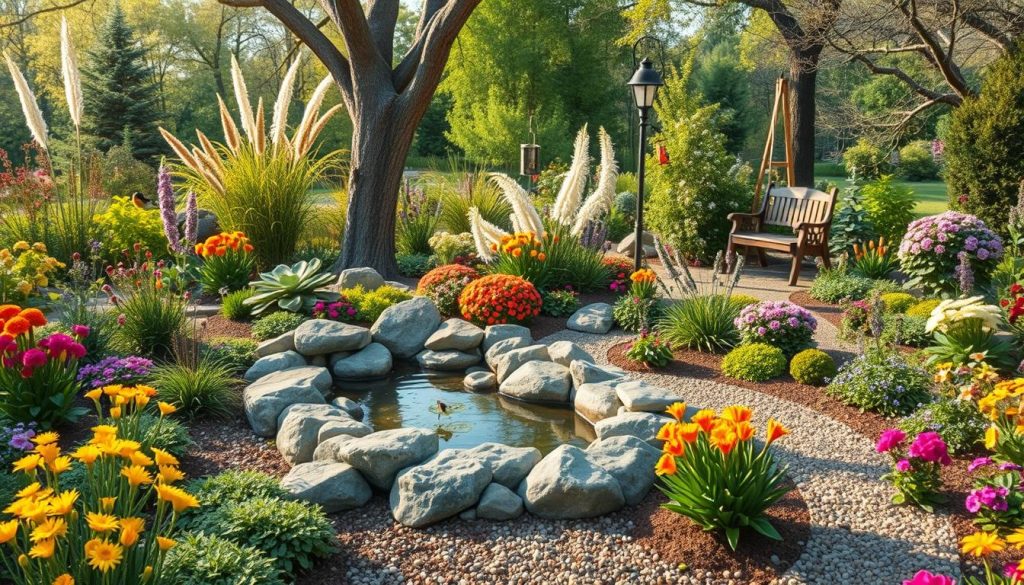
Selecting Native Plants for My Garden
Creating a wildlife-friendly garden starts with the right plants. Native plants attract local wildlife and offer food and shelter. A garden that supports pollinators is not only lovely but also helps the ecosystem.
For a successful wildlife garden, choose a mix of native plants. These plants have adapted to the local climate and soil. They are easier to care for and attract native wildlife.
Why Native Plants Matter
Native plants are key because they feed and shelter local wildlife. They also need less care since they fit the local environment well.
My Go-To Plant Choices
Here are some plants I always choose for a wildlife garden:
- Black-eyed Susans, which attract butterflies and bees
- Coneflowers, which attract birds and butterflies
- Milkweed, which is a vital food source for monarch butterflies
By using these plants, my garden has become a haven for wildlife. It supports the local ecosystem and draws in many native species.
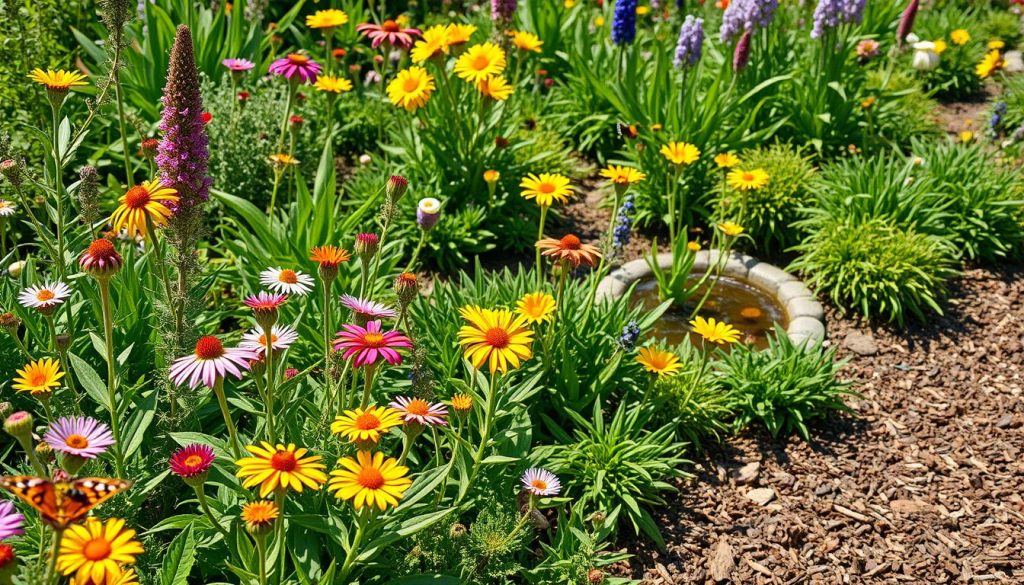
Incorporating Water Features
To make a backyard wildlife sanctuary, adding water features is key. You can have ponds, birdbaths, or small fountains. These not only look good but also give water to wildlife, helping your garden be more diverse.
Types of Water Features
Think about the space you have and the wildlife you want to draw in. A small birdbath is perfect for a small space, while a big pond can host more life. Here are some common water features:
- Ponds: They can be big or small and home many aquatic creatures.
- Birdbaths: These are shallow dishes that sit on a pedestal or on the ground.
- Fountains: They add a calming sound and water for wildlife.
Attracting Birds and Insects
To draw birds and insects, use eco-friendly gardening. Choose native plants and skip pesticides. This makes your garden a welcoming place for wildlife. With water features and eco-friendly gardening, your backyard can be a haven for many creatures.
Creating Shelter for Wildlife
As I work on my wildlife habitat garden, I see how vital shelter is for the creatures that visit. It boosts biodiversity and makes my garden a welcoming place for native plants and wildlife. By adding shelter, I help my local ecosystem and attract more wildlife to my garden.
To build shelter, I look at a few options:
- Birdhouses and bat boxes for birds and bats to nest
- Native shrubs and ground cover for hiding spots and protection
- Rock piles and log stacks for small mammals and insects
These features make my garden a haven for many species. Using native plants is key, as it meets the local wildlife’s needs. This way, my garden supports a diverse range of life.
I’m eager to see how sheltering wildlife will improve my garden’s health and biodiversity. It’s an exciting part of making my garden a thriving wildlife habitat.
| Shelter Option | Benefits |
|---|---|
| Birdhouses and Bat Boxes | Provide nesting sites, support local bird and bat populations |
| Native Shrubs and Ground Cover | Offer hiding places, protection from predators, and food sources |
| Rock Piles and Log Stacks | Create habitat for small mammals and insects, support ecosystem diversity |
Choosing Eco-Friendly Garden Practices
To make a wildlife-friendly garden, choose eco-friendly practices. Use sustainable landscaping to keep soil healthy and save resources. This way, you can attract wildlife and support local biodiversity.
Composting and Mulching
Composting and mulching are great for your garden. Composting turns organic waste into a soil booster. Mulching keeps soil moist, fights weeds, and controls temperature.
Natural Pest Control
Using natural pest control is key in eco-friendly gardening. Instead of chemicals, try barriers, beneficial insects, or neem oil. Here are some methods:
- Encourage beneficial insects, such as ladybugs and lacewings, to visit your garden
- Use physical barriers, such as fine mesh or fine netting, to prevent pests from reaching your plants
- Spray neem oil or insecticidal soap to control pests
By using these practices, you can make a sustainable garden. It will attract wildlife and support a healthy ecosystem.
Providing Food Sources
To make a wildlife habitat garden thrive, it’s key to offer different food types. A garden that welcomes pollinators should have plants that attract bees and butterflies. Native plants and flowers help create a diverse garden that supports many species.
Diverse Planting for Pollinators
Plants like coneflowers, black-eyed susans, and lavender are great for wildlife gardens. They are full of nectar and pollen, drawing in pollinators. Here are some tips for planting diversity:
- Choose a mix of annuals and perennials for ongoing food
- Use native plants that fit your area
- Plant flowers that bloom at different times for constant nectar and pollen
Bird Feeders and Supplementary Food
Bird feeders and extra food are also crucial for wildlife. Offering seeds, nuts, and fruits can attract many birds. Here’s a table with some bird feeder and food ideas:
| Food Source | Types of Birds Attracted |
|---|---|
| Seed Feeders | Sparrows, Finches, Cardinals |
| Nut Feeders | Woodpeckers, Chickadees, Blue Jays |
| Fruit Feeders | Robins, Bluebirds, Orioles |
By offering various food sources, you can make your garden a haven for wildlife. Pick food that fits your area and the wildlife you want to attract.
How I Attract Pollinators
To attract bees and butterflies, I make my garden welcoming. I plant nectar-rich flowers, like native plants and others. This helps pollinators and supports eco-friendly gardening.
Here’s how I do it:
- Plant a mix of flowers that bloom at different times for constant nectar.
- Use native plants and flowers to make a pollinator-friendly space.
- Offer water, like a shallow dish or birdbath, for them to drink.
By doing these things, you can also attract wildlife to your yard. A wildlife-friendly garden is good for the environment and makes your outdoor space beautiful.
Planting Nectar-Rich Flowers
Planting nectar-rich flowers is key to attracting pollinators. Sunflowers, zinnias, and cosmos are my top picks. They’re not just pretty; they also offer a lot of nectar.
Creating Pollinator-Friendly Spaces
Creating spaces for pollinators is crucial. Use native plants and flowers, provide water, and make your garden welcoming. These steps help create a thriving ecosystem and attract various wildlife, including pollinators.
Engaging with My Community
As I tend to my backyard wildlife sanctuary, I’ve learned how vital it is to share my journey. This way, I inspire others to create their own wildlife-friendly gardens. I also gain insights into eco-friendly gardening from their experiences.
I share my garden’s story online through social media. I post updates, tips, and photos. This connects me with others who love wildlife gardening. Their support, advice, and motivation have been invaluable.
I also join local wildlife gardening groups. These groups let me meet other gardeners and share knowledge. Together, we build a network of wildlife sanctuaries that support local biodiversity and eco-friendly gardening.
- Gaining knowledge and insights from experienced gardeners
- Sharing my own experiences and tips with others
- Building a network of like-minded individuals who support and motivate each other
- Contributing to the creation of a larger, more sustainable ecosystem
By connecting with my community and sharing my journey, I aim to inspire others. I hope to encourage them to create their own wildlife sanctuaries. This will help promote biodiversity and eco-friendly gardening.
| Benefits of Community Engagement | Description |
|---|---|
| Knowledge Sharing | Learn from experienced gardeners and share my own knowledge |
| Networking | Build relationships with like-minded individuals who support and motivate each other |
| Ecosystem Contribution | Contribute to the creation of a larger, more sustainable ecosystem |
Monitoring and Maintaining My Garden
To keep my wildlife habitat garden thriving, I regularly check on it. I watch for seasonal changes and adjust as needed. For example, in spring, I prune and mulch to help plants grow well and keep weeds away. In summer, I ensure there’s enough water for wildlife. And in fall, I collect seeds from native plants for next year’s garden.
Keeping a gardening journal is key for me. It helps me track my garden’s progress. I note the plants I’ve planted, the wildlife I’ve seen, and any challenges. This way, I can improve my garden and keep it diverse and vibrant.
- Planting schedules and seed starting dates
- Weather patterns and how they affect the garden
- Wildlife sightings and observations
- Pest and disease management strategies
By following these tips and staying committed, I’ve made a thriving ecosystem. It supports many native plants for wildlife and boosts biodiversity in my garden.
| Season | Task | Benefit |
|---|---|---|
| Spring | Pruning and mulching | Promotes healthy growth, prevents weeds |
| Summer | Providing water sources | Supports wildlife hydration and survival |
| Fall | Harvesting seeds | Conserves native plant species, supports future growth |
Celebrating the Wildlife in My Garden
Looking back, I feel joy and appreciation for the creatures in my garden. Hummingbirds flit among flowers, and bees buzz around plants. Each visitor shows the beauty and life of nature.
Birdwatching is a favorite hobby of mine. I’ve set up bird feeders and binoculars to see many birds. Watching their flight and antics is a joy. I keep a journal of the birds I see, tracking the diversity in my garden.
But it’s not just birds that interest me. Chipmunks, snakes, and monarch butterflies also fascinate me. By documenting these sightings, I learn about the life web in my backyard.
Maintaining my garden brings me joy. Seeing the ecosystem thrive is the best reward. Creating a wildlife-friendly garden connects us deeply with nature.

